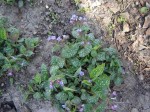Ask The Expert: I just recieved a lucky bamboo from my daughter, I was wondering about the tie around the stalks do I leave it or remove it.How do i tell if I’m adding enough water my plant is the one with stones in the container. Tarrie
Reply:
As long as the ties are not binding into the stems, you can leave them. People often add ribbon or ties to lucky bamboo (dracaena sanderiana) stalks for aesthetic reasons only. In fact, golden or red ribbon is used to symbolize additional good fortune.
Water level should be at least a couple of inches. Make sure the roots are covered with water; add water to keep the water level constant. Every couple of weeks change the water completely. Refill the container with clean water. Lucky bamboo is sensitive to the salts and chemicals in tap water; use distilled water or rainwater if possible. If you must use tap water let it set in an open container over night; this will let the chlorine evaporate. However, there is no way to remove the fluoride from the tap water. Fluoride can cause leaf tips to turn brown. Low humidity can cause leaf tips to turn brown as well. Mist the leaves of the lucky bamboo every couple of days if lack of humidity is a problem.
Good Luck with your lucky bamboo and keep me posted.


 Find Your
Find Your 
